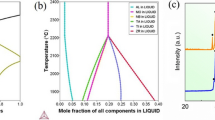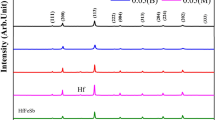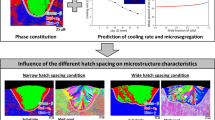Abstract
Effect of change in strain path by cross rolling up to a true strain of 1.89 has been studied in the present work. The Zircaloy-2 was subjected to solutionising heat treatment at 800 °C in argon environment for 2 h and subsequently quenched in mercury prior to cross rolling at room temperature. The fragmentation of near basal grains due to change in strain path is evident from the EBSD micrographs. The dislocation density in the crossrolled alloy increases with true strain as calculated from the XRD and EBSD data and it is found to be 2.806453 × 1016/m2. \( \left\{ {10\bar{1}2} \right\} \) extension twins are observed initially up to 25% reduction, with the further reduction in thickness, near basal grains are oriented toward the normal direction. These basal grains undergone fragmentation due to changes in strain path upon cross-rolling as observed from KAM and EBSD images. TEM results of the cross-rolled sample confirm the formation of ultrafine and nanograins in the alloy due to orientation of incidental dislocation boundaries in the direction of macroscopic plastic flow and post-annealing treatment of the deformed alloy. A tensile strength of 991 MPa with 7.5% ductility is observed in the 85% cross-rolled alloy. The cross-rolled alloy upon annealing at 400 °C for 30 min improves ductility to 11%.






Similar content being viewed by others
References
R.L. Mehan, F.W. Wiesinger, Mechanical Properties of Zircaloy-2. AEC Research and development report, 1961
E.F. Ibrahim applications-related phenomena for zirconium and its alloys, ASTM STP 458, American Society for Testing and Materials, 1969, p. 18–36
A.R. Massih, M. Dahlback, M. Limback, T. Andersson, and B. Lehtinen, Effect of beta-to-alpha phase transition rate on corrosion behaviour of zircaloy, Corros. Sci., 2006, 48, p 1154–1181
C. Degueldre, J. Raabe, G. Kuri, and S. Abolhassani, Zircaloy-2 secondary phase precipitate analysis by x-ray microspectroscopy, Talanta, 2008, 75, p 402–406
X. Menc and D.O. Northwood, Second phase particles in zircaloy-2, J. Nucl. Mater., 1989, 168, p 125–136
T. Jayakumar, P. Palanichamy, and B. Raj, Detection of hard intermetallics in b-quenched and thermally aged Zircaloy-2 using ultrasonic measurements, J. Nucl. Mater., 1998, 255, p 243–249
G. Ostberg, Crack propagation in hydrided zircaloy-2, Int. J. Fract. Mech., 1968, 4, p 95–98
R.Z. Valiev, R.K. Islamgaliev, and I.V. Alexandrov, Bulk nanostructured materials from severe plastic deformation, Prog. Mater Sci., 2000, 45, p 103–189
Y. Estrin and A. Vinogradov, Extreme grain refinement by severe plastic deformation: a wealth of challenging science, Acta Mater., 2013, 61, p 782–817
M. Vedani, P. Bassani, A. Tuissi, and G. Angella, Ultrafine grained alloys produced by severe plastic deformation: issues on microstructural control and mechanical behaviour, Metall. Sci. Technol., 2004, 19, p 21–30
A. Shokuhfar and O. Nejadseyfi, The influence of friction on the processing of ultrafine-grained/nanostructured materials by equal-channel angular pressing, J. Mater. Eng. Perform., 2014, 23, p 1038–1048
X. Cheng, T.G. Langdon, Z. Horita, and M. Furukawa, Using equal-channel angular pressing for the production of superplastic aluminum and magnesium alloys, J. Mater. Eng. Perform., 2004, 13, p 683–690
K. Rahimi Mamaghani and M. Kazeminezhad, The effect of direct and cross-rolling on mechanical properties and microstructure of severely deformed aluminum, J. Mater. Eng. Perform., 2014, 23, p 115–124
C. Vanitha, M. Kiran Kumar, G.K. Dey, D. Srivastava, R. Tewari, and S. Banerjee, Recrystallization texture development in single-phase Zircaloy, Mater. Sci. Eng. A, 2009, 519, p 251–260
F. Xu, R.A. Holt, and M.R. Daymond, Modeling lattice strain evolution during uniaxial deformation of textured Zircaloy-2, Acta Mater., 2008, 56, p 3672–3687
D. Lee, Role of plastic anisotropy in the fatigue behavior of zircaloy, Metall. Trans., 1972, 3, p 315–328
R.G. Ballinger and R.M. Pelloux, The effect of anisotropy on the mechanical behavior of Zircaloy-2, J. Nucl. Mater., 1981, 97, p 231–253
P. Mukherjee, A. Sarkar, P. Barat, S.K. Bandyopadhyay, P. Sen, S.K. Chattopadhyay, P. Chatterjee, S.K. Chatterjee, and M.K. Mitra, Deformation characteristics of rolled zirconium alloys: a study by x-ray diffraction line profile analysis, Acta Mater., 2004, 52, p 5687–5696
C.L. Whitmarsh, Oak Ridge National Laboratory Oak Ridge, Tennessee Operated “By Union Carbide Corporation For The US Atomic Energy Commission 1962, ORNL-3281 UC-80-Reactor technology TID-4500 (17th Edition).
S. Goel, R. Jayaganthan, I.V. Singh, D. Srivastava, G.K. Dey, and N. Saibaba, Mechanical and microstructural characterizations of ultrafine grained zircaloy-2 produced by room temperature rolling, J. Mater. Des., 2014, 55, p 612–618
E. Tenckhoff, Deformation mechanisms, texture, and anisotropy in zirconium and zircaloy. American Society for Testing and Materials, 1988
M.H. Yoo, Slip, twinning, and fracture in hexagonal close packed metals, Metall. Mater. Trans. A, 1981, 12, p 409–418
M. Knezevic, I.J. Beyerlein, T. Nizolek, N.A. Mara, and T.M. Pollock, Anomalous basal slip activity in zirconium under high strain deformation, Mater. Res. Lett., 2013, 1, p 133–140
K. Linga Murty and Indrajit Charit, Texture development and anisotropic deformation of zircaloys, Prog. Nucl. Energy, 2006, 48, p 325–359
R.J. McCabe, G. Proust, E.K. Cerreta, and A. Misra, Quantitative analysis of deformation twinning in zirconium, Int. J. Plast., 2009, 25, p 454–472
N. Hansen, New discoveries in deformed metals, Metall. Mater. Trans. A, 2001, 32, p 2917–2935
D.A. Hughes, N. Hansen, and D.J. Bammann, Geometrically necessary boundaries, incidental dislocation boundaries and geometrically necessary dislocations, Scr. Mater., 2003, 48, p 147–153
Qing Liu and Niels Hansen, Geometrically necessary boundaries and incidental dislocation boundaries formed during cold deformation, Scr. Metall. Mater., 1995, 8, p 1289–1295
A. Borbely and I. Groma, Variance method for the evaluation of particle size and dislocation density from x-ray Bragg peaks, Appl. Phys. Lett., 2001, 79, p 1972–1974
I. Groma, x-ray line broadening due to an inhomogeneous dislocation distribution, Phys. Rev. B, 1998, 57, p 7535–7542
A. Sarkar, P. Mukherjee, and P. Barat, x-ray diffraction studies on asymmetrically broadened peaks of heavily deformed zirconium-based alloys, Mater. Sci. Eng. A, 2008, 485, p 176–181
S.K. Sahoo, V.D. Hiwarkar, I. Samajdar, G.K. Dey, D. Srivastav, R. Tiwari, and S. Banerjee, Heterogeneous deformation in single-phase Zircaloy 2, Scr. Mater., 2007, 56, p 963–966
Y. Wang, M. Chen, F. Zhou, and E. Ma, High tensile ductility in a nanostructured metal, Nature, 2002, 419, p 912–914
D. Guo, M. Li, Y. Shi, Z. Zhang, H. Zhang, X. Liu, B. Wei, and X. Zhang, High strength and ductility in multimodal-structured Zr, Mater. Des., 2012, 34, p 275–278
D. Guo, M. Li, Y. Shi, Z. Zhang, T. Ma, H. Zhang, and X. Zhang, Simultaneously enhancing the ductility and strength of cryorolled Zr via tailoring dislocation configurations, Mater. Sci. Eng. A, 2012, 558, p 611–615
F.J. Humphreys and M. Hatherly, Recrystallization and related annealing phenomena, Elsevier, Oxford, 2004
R.J. Mccabe, E.K. Cerreta, A. Misra, G.C. Kaschner, and C.N. Tome, Effects of texture, temperature and strain on the deformation modes of zirconium, Philos. Mag., 2006, 86, p 3595–3611
G. Monnet, B. Devincre, and L.P. Kubin, Dislocation study of prismatic slip systems and their interactions in hexagonal close packed metals: application to zirconium, Acta Mater., 2004, 52, p 4317–4328
L. Li, T. Unga, Y.D. Wang, G.J. Fan, Y.L. Yang, N. Jia, Y. Ren, G. Tichy, J. Lendvai, H. Chooa, and P.K. Liawa, Simultaneous reductions of dislocation and twin densities with grain growth during cold rolling in a nanocrystalline Ni-Fe alloy, Scr. Mater., 2009, 60, p 317–320
N.P. Gurao and Satyam Suwas, Deformation mechanisms during large strain deformation of nanocrystalline Nickel, Appl. Phys. Lett., 2009, 94, p 191902
S.K. Sahoo, V.D. Hiwarkar, K.V. Mani Krishna, I. Samajdar, P. Pant, P.K. Pujari, G.K. Dey, D. Srivastava, R. Tiwari, and S. Banerjee, Grain fragmentation and twinning in deformed Zircaloy 2: response to positron lifetime measurements, Mater. Sci. Eng. A, 2010, 527, p 1427–1435
Acknowledgment
One of the authors, Dr. R. Jayaganthan, expresses his sincere thanks to BRNS Bombay, for their financial Grant to this work through Grant no. BRN-577-MMD.
Author information
Authors and Affiliations
Corresponding author
Rights and permissions
About this article
Cite this article
Goel, S., Keskar, N., Jayaganthan, R. et al. Development of Ultrafine Grained Zircaloy-2 by Room Temperature Cross Rolling. J. of Materi Eng and Perform 24, 609–617 (2015). https://doi.org/10.1007/s11665-014-1287-y
Received:
Revised:
Published:
Issue Date:
DOI: https://doi.org/10.1007/s11665-014-1287-y




